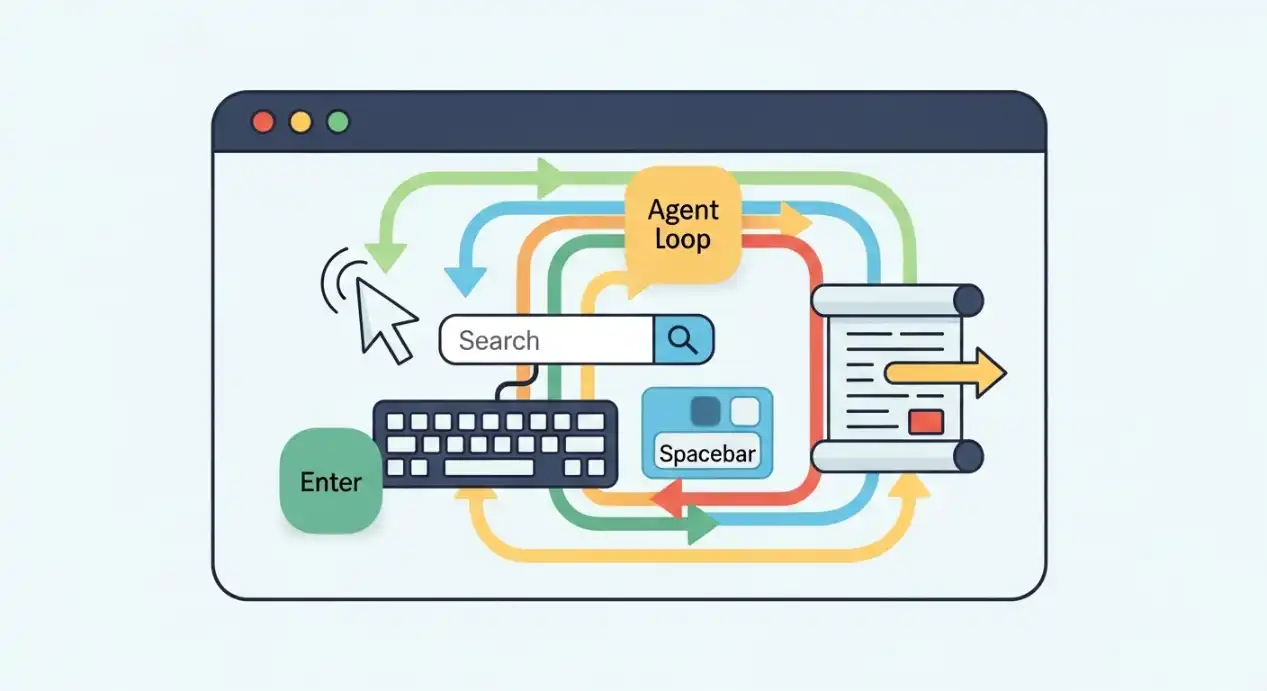Meet the AI that actually uses a browser like you do. Google’s new Gemini 2.5 “Computer Use” model can click, type, scroll, and submit forms—so your tedious web chores stop being… yours.
What Is Gemini 2.5 Computer Use?
Gemini 2.5 Computer Use is Google’s new agentic model (announced Oct 7, 2025) that operates a web browser through predefined UI actions—think of it as a tireless intern who knows where to click and when to hit “submit.” It’s built on Gemini 2.5 Pro’s vision and reasoning, and it ships in public preview via the Gemini API and Google Cloud’s Vertex AI.
How It Works
Under the hood, developers enable a new computer_use tool and run an “agent loop”:
- See: The model receives a screenshot (plus the task and recent action history).
- Reason: It decides the next UI action—e.g.,
open_web_browser,navigate,click_at,type_text_at,scroll,go_back. - Act: Your client (often with Playwright) executes the action, captures a fresh screenshot and URL, then sends them back for the next step.
The model currently prioritizes browser automation (with early promise for mobile UI control) and isn’t yet optimized for OS-level desktop control. It also includes guardrails: risky actions (like purchases) can require user confirmation, and there are controls to block disallowed behaviors (e.g., bypassing CAPTCHAs).
Benefits & Use Cases
- Automates repetitive web work — form filling, filtering, exporting, and basic data entry so teams can focus on higher-value tasks.
- UI testing at scale — simulate real user flows across sites, catching regressions without brittle DOM scripts.
- Research that touches the real web — compare prices, compile specs/reviews, and capture results even on sites without APIs.
Costs/Pricing
Vertex AI pricing (Preview) for Gemini 2.5 Pro Computer Use currently mirrors 2.5 Pro rates: approximately $1.25 per 1M input tokens and $10 per 1M output tokens (long-context >200K tokens billed at higher tiers). Computer Use usage bills under the Pro SKU, and standard grounding or other add-ons may bill separately. Google AI Studio has its own pricing/free-tier policies.
Tip: Agent loops reprocess context each turn; design prompts and caching to keep token use lean.
Local Insights (GEO)
For readers in Bangladesh and wider South Asia: Google AI Studio access is officially available in Bangladesh, so developers can try the preview without workarounds. Billing is in USD on Vertex AI, so plan for FX and regional tax considerations. Popular local use cases include e-commerce catalog ops (price checks, stock checks), government or utility portals (where terms allow), and QA for multilingual sites. Always respect site terms and privacy rules when automating.
Alternatives & Comparisons
- OpenAI Operator / Computer-Using Agent: Browser-using agent that navigates GUIs with GPT-4o, positioned inside ChatGPT/Agent Mode. Pros: tight ChatGPT integration, strong vision. Cons: access and API surface vary by tier; not always a general developer API like Gemini’s Computer Use.
- Anthropic Computer Use: Long-running effort to let Claude operate browsers (and, in some contexts, desktops). Pros: strong safety research and “agentic” guidance. Cons: feature availability and benchmarks may differ; check latest docs for OS vs browser scope.
Why pick Gemini 2.5 Computer Use? It’s API-first, emphasizes browser control, and has published, independently evaluated results on web control benchmarks—plus straightforward setup through AI Studio or Vertex AI.
Step-by-Step Guide
- Get access: In Google AI Studio (or Vertex AI), enable the model ID
gemini-2.5-computer-use-preview-10-2025. - Set up the runner: Use a sandboxed environment (VM/container) and install Playwright. Capture screenshots after each action.
- Wire the agent loop: Send the task + screenshot; parse the model’s
function_call(e.g.,click_at/type_text_at), execute, then return a new screenshot + URL. - Add safety: Honor require confirmation decisions for high-risk actions; explicitly exclude actions you don’t want (
excluded_predefined_functions). - Tune for reliability: Set sensible timeouts and retries, normalize coordinates (0–999 → pixels), and add custom functions for mobile use cases if needed.
- Measure & optimize: Track success rate, latency, and tokens per task; trim context to cut cost.
FAQs
Is Gemini 2.5 Computer Use worth it?
If your team spends hours clicking around the web, yes—especially for UI testing and recurring workflows where DOM scraping is brittle or impossible.
How long does it take?
Most teams can stand up a basic demo quickly with AI Studio + Playwright, then harden it with retries, confirmations, and logging as they scale.
Any risks or downsides?
It’s a preview model focused on browsers, not desktop OS control. Sites change, CAPTCHAs exist, and some actions require user confirmation. Always follow site terms and test thoroughly.
Bottom Line
Gemini 2.5 “Computer Use” turns agentic browsing from a demo into a practical API. If you’ve got web tasks that never end, it’s time to hand the mouse to your model. Share this with your team and subscribe for our next deep-dive!
Sources
- Google Blog — Introducing the Gemini 2.5 Computer Use model
- Google AI for Developers — Computer Use (Gemini API)
- Vertex AI Docs — Computer Use model and tool
- Vertex AI — Generative AI Pricing (Gemini 2.5 & Computer Use Preview)
- Google AI Studio — Available Regions (includes Bangladesh)
- Browserbase — Training & Evaluating Browser Agents (with Gemini 2.5)
- The Verge — Google’s model uses a web browser like you do
- SiliconANGLE — Gemini 2.5 Computer Use can navigate the web like a human
- OpenAI — Introducing Operator (Computer-Using Agent)
- Anthropic — Piloting Claude for Chrome (safety & browser-using agents)

